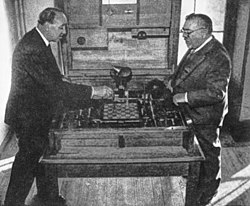El Ajedrecista

El Ajedrecista (Template:Lang-en) was an automaton built in 1912 by Leonardo Torres y Quevedo. It created great excitement when it made its debut, at the University of Paris in 1914. It was first widely mentioned in Scientific American as "Torres and His Remarkable Automatic Devices" on November 6, 1915.[2] Using electromagnets under the board, it automatically played an endgame with three chess pieces, moving a king and a rook to checkmate a king moved by a human opponent. The device is considered the first computer game in history.[3]

The automaton does not deliver checkmate in the minimum number of moves, nor always within the 50 moves allotted by the fifty-move rule, because of the simple algorithm that calculates the moves. It did, however, checkmate the opponent every time. If an illegal move was made by the opposite player, the automaton would signal it.[4]
Its internal construction was published by H. Vigneron.[5] Leonardo's son Gonzalo made an improved chess automaton based on El Ajedrecista in 1920, which made its moves via magnets located under the board.[6] Both are still working and are on display at the Colegio de Ingenieros de Caminos, Canales y Puertos in Madrid. As opposed to the human-operated The Turk and Ajeeb, El Ajedrecista was a true automaton built to play chess without human guidance.
Notes
- ^ "Chess Programming Wiki- Leonardo Torres y Quevedo". Retrieved 2010-06-12.
- ^ Torres and his remarkable automatic devices. Issue 2079 of Scientific American, 1915
- ^ Montfort, Nick (2003). Twisty Little Passages: An Approach to Interactive Fiction. MIT Press. p. 76. ISBN 0-262-63318-3.
In 1912 Leonardo Torres Quevedo ... devised the first computer game ... The machine played a KRK chess endgame, playing rook and king against a person playing a lone king.
- ^ Atkinson, George W. (1998). Chess and machine intuition. Intellect Books, pp. 21-22. ISBN 1-871516-44-7
- ^ H. Vigneron: Robots. English Translation in: David Levy, Monty Newborn: Chess and Computers, pp. 13-23. Computer Science Press, 1982.
- ^ Brian Randell, From Analytical Engine to Electronic Digital Computer: The Contributions of Ludgate, Torres and Bush. Annals of the History of Computing, Vol. 4, No. 4, Oct. 1982
